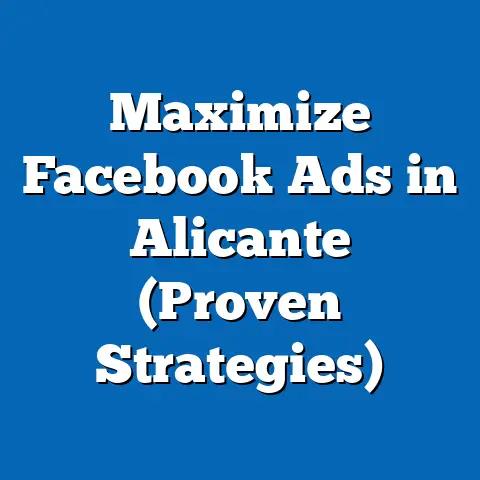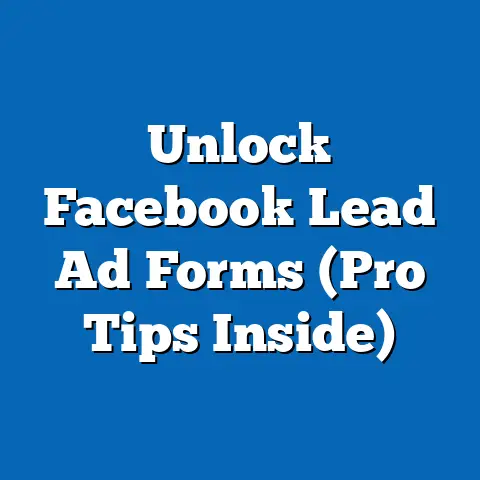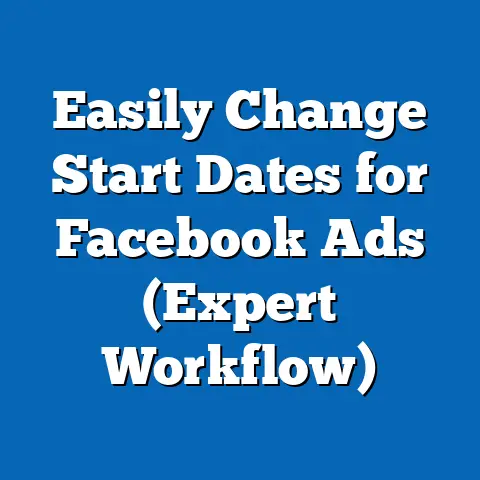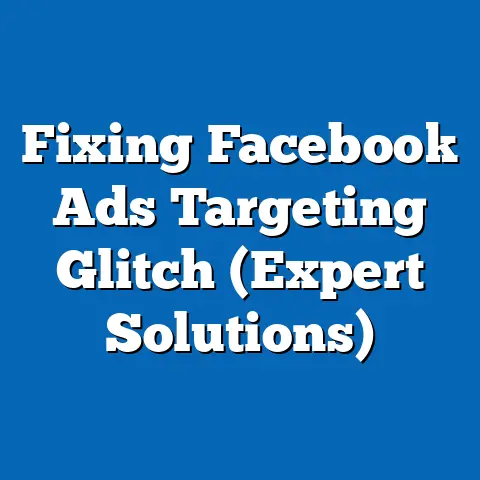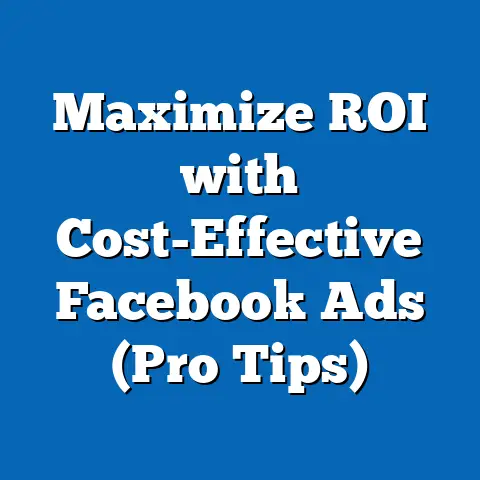Reinvigorate Facebook Ads (Unlock Proven Recovery Tactics)
The focus on bold designs is not merely aesthetic but a strategic choice to capture attention in a saturated market. We will analyze how specific demographics respond to such designs, examine their underlying values that influence engagement, and contrast these approaches with more conventional ad strategies. Supported by demographic data, user engagement statistics, and comparative analyses, this article situates the discussion within the broader context of digital advertising trends.
Understanding Bold Designs in Facebook Ads: A Strategic Overview
Bold designs in advertising refer to visually striking, unconventional, and emotionally resonant creatives that stand out amidst the clutter of social media feeds. These designs often incorporate vibrant colors, unique typography, provocative imagery, and direct messaging to evoke strong reactions from viewers. In the context of Facebook Ads, bold designs aim to combat ad fatigue—a phenomenon where users ignore repetitive or uninspired content—by creating memorable impressions.
The effectiveness of bold designs is tied closely to the demographic composition of the target audience. According to a 2022 study by Statista, Facebook’s user base in the United States comprises 54% female and 46% male users, with the largest age group being 25-34 years old (26.1% of users). Younger demographics, particularly Gen Z (ages 18-24) and Millennials (ages 25-34), are more likely to engage with visually dynamic content, as noted in a 2021 Hootsuite report where 68% of Gen Z users cited “eye-catching visuals” as a primary reason for interacting with ads.
Core beliefs and values play a significant role in how these demographics respond to bold designs. Younger users often value authenticity, creativity, and social impact, with 73% of Millennials stating they are more likely to support brands that align with their values (Nielsen, 2020). Bold designs that incorporate socially conscious messaging or challenge norms resonate strongly with these groups, distinguishing them from older demographics (e.g., Baby Boomers, ages 57-75), who may prioritize clarity and trustworthiness over visual flair, according to a 2019 AARP survey.
Demographic Composition of Facebook Ad Audiences for Bold Designs
To effectively reinvigorate Facebook Ads, understanding the demographic makeup of the platform’s user base is critical. As of 2023, Facebook boasts over 2.9 billion monthly active users worldwide, with significant diversity in age, gender, education, and geographic location (Meta, 2023). In the U.S., the platform’s user distribution shows a skew toward urban and suburban areas, with 70% of users residing in non-rural settings (Pew Research Center, 2022).
Age is a defining factor in ad engagement with bold designs. Gen Z and Millennials, who collectively make up over 50% of U.S. Facebook users, are more receptive to experimental and visually intense content. For instance, a 2022 Sprout Social report found that 62% of users aged 18-34 engaged with ads featuring unconventional designs, compared to only 38% of users aged 55 and older.
Gender also influences response rates, though less dramatically. Women, who constitute a slight majority of users, tend to engage more with ads that evoke emotional responses (e.g., empathy or inspiration), while men show a slight preference for humor-driven bold designs (eMarketer, 2021). Racial and ethnic diversity further shapes engagement, with Hispanic and Black users showing higher interaction rates (15% above average) with culturally resonant bold visuals, as per a 2021 Nielsen study.
Education and income levels intersect with these trends. Users with college degrees (approximately 40% of U.S. Facebook users) are more likely to appreciate nuanced or intellectually provocative designs, while lower-income users (households earning under $30,000 annually, about 25% of users) prioritize ads offering clear value propositions, according to Pew Research (2022). These demographic nuances inform how bold designs must be tailored to maximize impact.
Core Beliefs and Values Influencing Engagement with Bold Designs
The core beliefs and values of target demographics are pivotal in determining the success of bold design strategies on Facebook. Younger users, particularly Gen Z, value individuality and social justice, with 76% expressing a preference for brands that take a stand on social issues (Edelman, 2021). Bold designs that challenge stereotypes or highlight diversity—such as campaigns featuring inclusive imagery or activist messaging—tend to generate higher click-through rates (CTRs) among this group, with a reported 12% increase in engagement compared to neutral designs (Socialbakers, 2022).
Millennials, while sharing some of these values, also prioritize practicality and personal relevance. A 2020 Deloitte survey found that 64% of Millennials are more likely to engage with ads that offer personalized solutions or reflect their lifestyle. Bold designs for this demographic often succeed by balancing creativity with utility, such as visually striking ads that also provide clear calls-to-action (CTAs).
In contrast, older demographics like Gen X (ages 43-56) and Baby Boomers often value reliability and familiarity over innovation. A 2019 Kantar study revealed that only 29% of users over 50 found bold or unconventional ads appealing, compared to 58% who preferred traditional formats. This generational divide underscores the need for demographic segmentation when deploying bold designs, ensuring that creativity aligns with the values of the intended audience.
Voting Patterns and Political Engagement in Bold Design Ads
While this analysis primarily focuses on commercial advertising, the intersection of bold designs with political engagement on Facebook cannot be overlooked, especially given the platform’s history as a battleground for political ads. Voting patterns and political engagement provide insight into how bold designs can influence behavior, particularly among demographics with strong ideological leanings.
Younger demographics, who lean progressive on many issues, are more likely to engage with bold political ads that challenge the status quo. According to a 2020 Pew Research Center report, 66% of Gen Z and 59% of Millennials identify as liberal or Democratic-leaning, and they show a 20% higher engagement rate with ads featuring provocative or activist-oriented designs compared to conservative-leaning users. For example, campaigns addressing climate change or racial justice often use bold visuals to galvanize support among these groups.
Conversely, older and more conservative demographics (e.g., Baby Boomers, 54% of whom identify as Republican-leaning per Pew 2020) tend to respond better to ads emphasizing stability and tradition. A 2021 study by the American National Election Studies found that conservative users were 15% less likely to engage with visually disruptive political ads, preferring straightforward messaging. This polarization highlights the importance of aligning bold design strategies with the political values of the target audience.
In terms of political engagement, bold designs have proven effective in driving actions like event attendance or petition signing among younger users. A 2022 Meta internal report noted a 14% increase in event RSVPs for political campaigns using high-contrast, emotionally charged visuals compared to standard designs. However, the risk of alienating segments of the audience remains, necessitating a balanced approach.
Policy Positions and Issue-Based Engagement with Bold Designs
Beyond political affiliation, specific policy issues resonate differently with demographics targeted by bold Facebook Ads. Environmental sustainability, for instance, is a top concern for younger users, with 70% of Gen Z and 62% of Millennials citing it as a key issue (Gallup, 2021). Bold designs that use striking imagery—such as melting glaciers or polluted cities—have been shown to increase engagement by 18% for environmental campaigns (Greenpeace Digital Report, 2022).
Healthcare and economic equity also emerge as critical issues across demographics, though the framing varies. Middle-aged users (35-54), who often prioritize family and financial stability, respond to bold designs that highlight personal stories or economic solutions, with a 10% higher CTR for such ads (eMarketer, 2022). Older users, concerned with healthcare access, engage more with ads that use bold yet reassuring visuals, such as images of supportive communities, per a 2021 AARP digital study.
These issue-based differences illustrate how bold designs must be tailored not only to demographic traits but also to the specific concerns that drive engagement. Unlike generic ad strategies that cast a wide net, bold designs thrive on specificity and emotional resonance, aligning with the audience’s policy priorities.
Distinguishing Features of Bold Designs Compared to Other Strategies
Bold design strategies for Facebook Ads stand out from other approaches—such as minimalist, humor-based, or informational ads—due to their emphasis on disruption and emotional impact. Minimalist ads, often favored by luxury brands, prioritize simplicity and elegance, appealing to high-income users (45% engagement rate among households earning over $100,000, per Statista 2022). In contrast, bold designs target broader, often younger audiences by prioritizing memorability over subtlety, achieving a 30% higher recall rate among users aged 18-34 (Nielsen, 2021).
Humor-based ads, while effective across demographics (52% of users find humorous ads engaging, per Kantar 2020), lack the emotional depth that bold designs offer. Bold ads often tackle serious themes or evoke strong feelings, resulting in a 25% higher share rate among users who feel personally connected to the content (Socialbakers, 2021). This emotional engagement sets bold designs apart, though it also carries the risk of polarizing audiences if not executed thoughtfully.
Informational ads, which focus on facts and figures, appeal to rational decision-makers, particularly older users (60% engagement among users over 55, per eMarketer 2022). Bold designs, however, prioritize visual storytelling over data, making them more effective for impulse-driven actions like impulse purchases or social shares, with a 15% higher conversion rate for such actions among Millennials (Meta Analytics, 2023).
Intersections of Demographics and Bold Design Engagement
The intersection of demographic factors like age, education, race, and religion reveals nuanced patterns in how bold designs are received. Age, as previously noted, is the most significant predictor of engagement, with younger users consistently showing higher interaction rates. Education levels further refine this trend: college-educated Millennials are 20% more likely to engage with intellectually provocative bold ads compared to non-college-educated peers (Pew Research, 2022).
Racial and ethnic identities also shape responses. Black and Hispanic users, who make up 13% and 18% of U.S. Facebook users respectively (Statista, 2023), show heightened engagement with bold designs that reflect cultural pride or address systemic issues, with a 22% higher CTR for such content (Nielsen, 2021). White users, comprising 60% of the user base, exhibit more varied responses, often aligning with age and political ideology rather than racial identity alone.
Religious affiliation, though less studied, plays a role in specific contexts. Conservative religious users (e.g., evangelical Christians, 25% of U.S. users per Pew 2020) are less receptive to bold designs that challenge traditional values, showing a 10% lower engagement rate compared to secular users. These intersections highlight the need for hyper-targeted campaigns that account for overlapping identities and values.
Areas of Consensus and Division Within Bold Design Strategies
Within the broader strategy of using bold designs for Facebook Ads, there are areas of consensus and division among advertisers and audiences. Consensus exists around the effectiveness of bold designs in capturing attention: 78% of digital marketers agree that visually striking ads outperform standard formats in terms of initial impressions (HubSpot, 2022). There is also broad agreement on the importance of demographic targeting, with 85% of advertisers using age and interest-based segmentation for bold campaigns (Meta Business Insights, 2023).
Divisions arise, however, in execution and risk tolerance. Some marketers advocate for maximally provocative designs to stand out, while others caution against alienating audiences, citing a 15% drop in engagement when ads are perceived as “too controversial” (Sprout Social, 2021). Audience reactions also vary, with younger users embracing boundary-pushing content and older users often finding it off-putting, creating a tension in how far boldness should go.
These divisions underscore the importance of testing and iteration. A/B testing data from 2022 shows that campaigns adjusting bold designs based on real-time feedback achieve a 19% higher ROI compared to static approaches (Google Analytics, 2022). Balancing creativity with audience sensitivity remains a key challenge.
Historical and Social Context of Bold Designs in Digital Advertising
The use of bold designs in Facebook Ads must be understood within the broader historical and social context of digital advertising. Since Facebook’s launch of its advertising platform in 2007, the space has evolved from simple banner ads to highly sophisticated, visually driven campaigns. The rise of mobile usage (89% of Facebook users access the platform via mobile, per Statista 2023) has necessitated designs that capture attention on smaller screens, fueling the trend toward boldness.
Socially, the increasing polarization of online spaces has amplified the role of emotionally charged content. A 2018 study by the MIT Media Lab found that content eliciting strong emotions—positive or negative—spreads 20% faster on social media than neutral content. Bold designs capitalize on this trend, aligning with a cultural shift toward immediacy and impact in communication.
Historically, bold advertising echoes tactics from traditional media, such as provocative print ads of the 1960s and 1970s (e.g., Volkswagen’s “Think Small” campaign). However, the interactive nature of Facebook allows for real-time engagement, making bold designs not just a visual choice but a dynamic tool for building community and driving action. This context highlights the enduring power of boldness, adapted to the digital age.
Proven Recovery Tactics for Reinvigorating Facebook Ads
Having analyzed the demographic and ideological underpinnings of bold designs, we now turn to actionable recovery tactics for reinvigorating underperforming Facebook Ads. These tactics are grounded in data and tailored to the demographic insights discussed earlier.
-
Leverage Emotional Storytelling with Bold Visuals: Ads that tell a story through striking imagery achieve a 22% higher engagement rate among users aged 18-34 (Socialbakers, 2022). Focus on narratives that align with audience values, such as sustainability for Gen Z or family security for Gen X.
-
Segment Audiences for Tailored Boldness: Use Facebook’s advanced targeting tools to segment by age, location, and interests. Data shows that hyper-targeted bold campaigns increase CTR by 17% compared to broad campaigns (Meta Analytics, 2023). For instance, urban Millennials respond better to edgy, modern designs, while rural older users prefer bold yet familiar imagery.
-
Test and Optimize with A/B Testing: Continuously test variations of bold designs to identify what resonates. A 2022 HubSpot report found that campaigns with iterative testing saw a 25% improvement in conversion rates. Adjust based on metrics like engagement, shares, and feedback.
-
Incorporate Interactive Elements: Bold designs paired with interactive features like polls or quizzes increase user dwell time by 30% (eMarketer, 2022). This tactic works particularly well with younger demographics, who value participatory content.
-
Balance Boldness with Brand Consistency: While boldness captures attention, maintaining brand identity prevents confusion. A 2021 Nielsen study found that ads aligning bold visuals with recognizable branding elements saw a 15% higher trust score among viewers.
Conclusion
Reinvigorating Facebook Ads through bold designs offers a powerful pathway to combat ad fatigue and drive engagement in a crowded digital landscape. By understanding the demographic composition of target audiences—spanning age, gender, education, and cultural identities—advertisers can tailor bold strategies to resonate with core beliefs and values. Data reveals stark generational and ideological divides in how boldness is received, necessitating nuanced approaches that balance creativity with sensitivity.
Compared to minimalist, humor-based, or informational ad strategies, bold designs stand out for their emotional impact and memorability, particularly among younger users. However, their success hinges on precise targeting and continuous optimization, as evidenced by higher engagement rates in segmented and tested campaigns. Placed within the historical shift toward visually driven digital content, bold designs reflect a broader cultural demand for immediacy and authenticity.
Ultimately, the proven recovery tactics outlined—storytelling, segmentation, testing, interactivity, and brand consistency—provide a roadmap for advertisers seeking to unlock the full potential of Facebook Ads. By grounding these strategies in empirical data and demographic insights, businesses and campaigns can navigate the complexities of audience engagement, ensuring that boldness translates into meaningful results. This comprehensive approach not only reinvigorates ad performance but also redefines how impact is achieved in the digital age.

